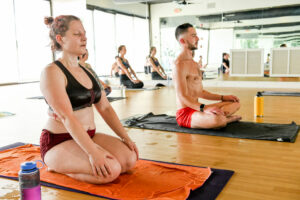YogaSol > mental health >
In June of 2022, 3.5 million viewers tuned in to watch the Johnny Depp defamation trial, and many more followed the proceedings on social media channels. Many of those viewers were hearing about Borderline Personality Disorder for the first time.
Is this new focus on BPD helping or harming the community?
While naming the disorder can give individuals the language necessary to express their needs, practitioners know focusing on behaviors brings healing. And most mental health professionals use somatic experiences to treat BPD and PTSD. Why? Because somatic experiences help people reconnect with their bodies and live healthier, happier lives. They help people diagnosed with BPD and PTSD regain control while living with these frequently stigmatized labels.
Somatic Experiences Promote Mental Health for Anyone With Trauma
Most of us have experienced some trauma in our lives. And trauma experiences leave a disconnect between your inner self and physical body. If you’re interested in the scientific work on this topic, grab a copy of The Body Keeps the Score: Brain, Mind, and Body in the Healing of Trauma by Vessel Van der Kolk, MD.
“As I often tell my students, the two most important phrases in therapy, as in yoga, are “Notice that” and “What happens next?” Once you start approaching your body with curiosity rather than with fear, everything shifts.” – The Body Keeps the Score
Yoga, pilates, and breathwork are three routes to reunite the mind and body after trauma. Read on to learn more about the link between somatic experiences and mental health. In short, we believe yoga is key to embracing healthier behaviors.
What Is Somatic Experiencing?
The word “somatic” comes from the Greek word soma, which means “body.” Thus, somatic therapy involves doing work to help people feel embodied. Somatic experiencing draws the mind’s attention to the physical body. As a result, individuals can learn to live healthier lives after traumatic experiences.
Somatic experiencing therapy does not seek to evoke traumatic memories. Instead, there is a focus on mindfulness. You will learn to notice and live in your body exactly as it is in the moment.
This practice is a therapeutic modality for individuals with Borderline Personality Disorder and PTSD. Trauma lives in your body, so focusing strictly on the mind only addresses half the problem. Additionally, individuals who do not carry a diagnosis can benefit from a somatic practice as part of their path toward overcoming trauma.
Reconnecting With Your Body
Your brain wants one thing and one thing only: to keep you safe. Its attempts at protection can lead to trauma responses that might not make sense, even to you. Consequently, individuals living with BPD and PTSD often face constant dysregulation of the nervous system and bodily experiences.
Sometimes, a nervous system under stress creates a disconnect between your mind and body. You might feel like “a person and a body” instead of “a person with a body.” As a result of this divide, you may have trouble heal from trauma.
Somatic experiences can reunite your mind and body. For instance they teach you to notice how you exist in the world. Practicing focuses on internal awareness, spatial orientation, and movement. Sound familiar? That’s because we use those practices in every yoga class. Consequently, many people feel their new physical awareness give them control of parts of themselves that felt removed or far away.
Evidence of Positive Outcomes
In 2017, the Journal of Traumatic Stress published an international study on the efficacy of somatic experiencing for individuals with PTSD. The researchers found somatic therapy was an effective treatment for PTSD. That’s because they noted participants’ positive outcomes.
But what about BPD? Most psychological professionals agree. Borderline Personality Disorder and Post Traumatic Stress Disorder are very similar. That’s why, it’s common for both diagnoses to occur together in one individual.
Somatic experiencing therapy addresses the same mind-body disconnect in people with both diagnoses. Therefore, most therapists believe we can assume the positive effects from the study also transfer to individuals living with BPD.
Other Examples of Studies Revealing Positive Outcomes
- A 2007 study by Leitch on SE and tsunami survivors
- A 2008 study by Parker, Doctor, and Selvam on SE and tsunami survivors
- A 2009 study by Leitch, Vanslyke, and Allen on SE and hurricane survivors
- A 2017 study by Andersen and collaborators on SE and PTSD
- A 2018 study by Winblad, Changaris, and Stein on trauma survivors
The most compelling outcomes come from individuals living with BPD and PTSD. We urge you to look up some testimonials on Youtube or your favorite podcasting app. For instance, you might start with the TEDx talk from Monica LeSage.
Yoga and Pilates as Somatic Experiences
You might have preconceived notions when you think of “trauma therapy.” For instance, does your mind go to a stiff office or a circle of folding chairs in a community center basement? What if therapy happened in a comfortable community? What if you could experience therapy on a mat with music playing over a state-of-the-art sound system?
Yoga and pilates are both forms of somatic therapy for mental wellness.
Yoga is an ancient practice that combines physical poses with meditation and breathing techniques. The goal is to connect the mind, body, and spirit. Similarly, somatic experiencing therapy has the same goal. Yoga focuses on presence and mindfulness. And that helps individuals work on actively inhabiting their bodies.
Pilates focuses on helping people attain a new freedom of movement and flexibility. The precise physical work emphasizes breath control. To participate in pilates, you must be present, focused, and specific, which is another goal of somatic therapeutic practices.
You might prefer yoga if you are comfortable with or specifically seeking a spiritual component to your whole-body therapeutic practice. You might choose pilates if you are working on taking up space and building strength in the aftermath of trauma. Both modalities are effective pathways toward improved healing and mindfulness. And using them together can give you a more full therapeutic experience.
Breathing as a Somatic Experience
Both pilates and yoga emphasize breath work. Breathing is a natural and automatic biological process. Therefore, actively noticing your breath helps you learn where and how your body holds stress.
So, what is the connection between breath and somatic experiences? Breath work brings your nervous system into an altered state. If your nervous system has entered a maladaptive cycle after trauma, this focus on the internal might be the release you need to find relief.
Practitioners also believe breath work deactivates the sympathetic nervous system. In other words, that system produces the trauma responses that keep you safe under extreme stress. Consequently, actively disrupting the cycle, can return you to a new equilibrium and play a more active role in controlling your behavior.
Yoga, Pilates, and Breath work
Yoga often emphasizes vocal vibrations. Your instructor will help you gain awareness of your prana or “life energy.” You will learn to tune into your energy and the energy of the students around you.
Even if you have never attended a yoga class, you might be familiar with the practice of engaging in a collective “om.” It allows you to become part of a group consciousness and helps you to feel present in your body. The act of noticing is a milestone on the somatic journey of many individuals with PTSD and BPD.
Likewise, pilates involves frequent reminders to breathe. You’ll hear that from your instructor more than nearly anything else! You will constantly be redirecting inward toward your breathing as you learn to take up space inside your skin.
You can also apply the mindful breathing techniques you learn in yoga and pilates outside the studio. They will become tools in your arsenal during moments of dissociation or extreme stress. Regular practice makes these techniques more accessible and intuitive.
Somatic Experiences Are for Everyone
Are somatic experiences beneficial for individuals who do not suffer from PTSD or BPD? Of course!
We live in a dynamic world full of stressors, grief, and change. Everyone can benefit from the opportunity to focus inward and reconnect with their body.
A few of the benefits of somatic experiences that improve life for those with and without mental health diagnoses include:
- Reduction of physical pain
- Less daily stress
- More open and positive affect
- Lower aggression
- Improved focus and concentration
- Higher confidence and self-esteem
- Greater resiliency
- Better sleep
- Improved physical health
Individuals with and without mental health diagnoses might also experience low moods. Seasonal affective disorder impacts 10 million Americans each year. SAD can lead to a decreased energy level and loss of interest in activities or socialization.
A standing appointment to attend a yoga or pilates class is sometimes enough to encourage people to leave home on their darkest days. Somatic experiences tend to build energy and reinvigorate the mind. Yoga and pilates can help all individuals stay positive and continue to lead productive lives.
Achieve Mental Wellness at YogaSol
Our brains and bodies are intuitive. They will do all they can to protect us from the trauma of the world. Yoga, pilates, and breathwork are incredible somatic experiences that can help individuals living with trauma learn to inhabit their bodies and thrive.
Your somatic experiencing therapy journey can begin at YogaSol in Norwalk, CT. YogaSol is an open, accepting environment where we prioritize the connection between mind and body. Book a class to experience the link between mental health and somatic experiencing for yourself.
 -ing our NEW! Community Classes!
-ing our NEW! Community Classes!




